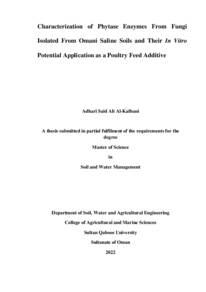Document
High fungal diversity and dominance by ascomycota in dam reservoir soils of arid climates.
Identifier
DOI: 10.17957/IJAB/15.0328
Source
International Journal of Agriculture and Biology. v. 19 (4), p. 682-688
Contributors
Al-Khatriyah, Badriya., Author
Nasehi, Abbas., Author
Al-Shihiyah, Muneera., Author
Al-Mahmooli, Issa H., Author
Country
Oman.
City
Muscat
Publisher
Friends Science Publishers.
Gregorian
2017-01-01
Language
English
English abstract
The study analyzed fungal diversity in soil trapped behind dams in three arid regions of Oman, in the south-eastern part of the Arabian Peninsula. Physicochemical analysis indicated that soils are of the loamy sand or sandy loam types and they are deficit in some macro and micro elements. Culture-based techniques revealed variation between dam soils in the number and type of phyla, classes, orders, genera and species. Ascomycota was the most dominant phyla in the three samples, contributing to 89% of the total species. Eurotiomycetes, Sordariomycetes and Dothideomycetes were the most common classes in dam soils. Zygomycetes, Pezizomycetes and Oomycetes were also detected, but at lower levels. Fifty fungal taxa were recovered from the three dam soils, with Aspergillus, Penicillium and Trichoderma being the most common genera. Most of the detected species were saprophytes; however some were either plant pathogens or mycotoxin producers, affecting humans directly or indirectly. This study appears to report for the first time 20 fungal species in Oman. It is also the first study from arid regions to characterize high fungal diversity in soil trapped behind dams. The sources of these fungi in dam soils and the implications of fungal diversity are discussed.
ISSN
1560-8530
Category
Journal articles

